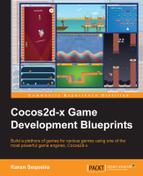Now that we have walls, let's create our first GameObject class that will represent the base platform. When I say base platform, I mean the trampoline the clown will be trying relentlessly to jump off at the start of the game. We define the CreateBasePlatform function in GameWorld.cpp:
void GameWorld::CreateBasePlatform()
{
// base platform will be a static body
b2BodyDef platform_def;
platform_def.position.Set(SCREEN_TO_WORLD(416),
SCREEN_TO_WORLD(172));
b2Body* base_platform_body = world_->CreateBody(&platform_def);
// create an edge slightly above the bottom of the screen
b2EdgeShape base_platform_shape;
base_platform_shape.Set(b2Vec2(SCREEN_TO_WORLD(-SCREEN_SIZE.width),
0.45f), b2Vec2(SCREEN_TO_WORLD(SCREEN_SIZE.width), 0.45f));
b2FixtureDef base_platform_fixture_def;
base_platform_fixture_def.shape = &base_platform_shape;
// give the base platform perfectly elastic collision response
base_platform_fixture_def.restitution = 1.0f;
base_platform_body->CreateFixture(&base_platform_fixture_def);
// create base platform, set physics body & add to batch node
base_platform_ = GameObject::create(this, "cjtrapm01.png");
base_platform_->SetBody(base_platform_body);
base_platform_->SetType(E_GAME_OBJECT_PLATFORM);
sprite_batch_node_->addChild(base_platform_, E_LAYER_CLOWN - 1);
}As you can see, a lot of the code is similar to the code used in creating the walls, except for one minor detail. Here, we actually create a b2FixtureDef object instead of using the shape to create the fixture. We do so because we want to set the value for the restitution of the base platform's fixture. We set the restitution to 1.0f because that is what every clown's dream trampoline should be like—perfectly elastic—and also because we want the clown to keep jumping till the user makes the move.
We then proceed to call the create function of GameObject, passing in a reference to GameWorld and specifying the sprite's frame name. This will return an auto-release GameObject. All that's left is to set its physics body and type before finally adding it to the game's batch node.
